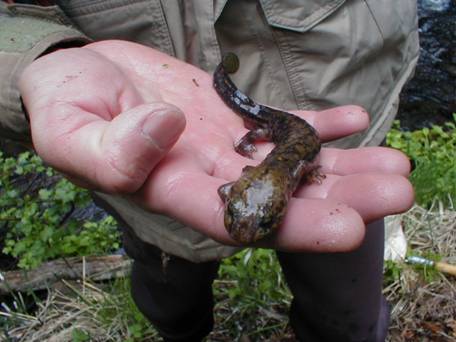his is North America’s largest terrestrial salamander (the aquatic one for a later time!). These critters grow to about 13 inches in total length. They range from southern B.C, through western WA and OR, and into northern CA and northern Idaho. They are not found on the Olympic Peninsula where a closely related species, Cope’s giant salamander lives. These salamanders have a very interesting life history and they are more commonly observed in their aquatic, larval phase than in their adult terrestrial form because the adults spend much of the time underground.
Females lay eggs in a water filled chamber, often under a log or rock, and will guard the nest until the young hatch and disperse. They are thought to mate every other year. The young larvae have gills and are aquatic during this stage. Here’s where it gets odd. Some larvae will never get rid of their gills and become terrestrial dwellers and will mate in this aquatic form, while others will transform into adults and lose their gills. It’s not clear how or why this occurs.
When you do run into an adult it will often be within 50 ft of a stream when they have come up from underground during warm spring rains. Not much is known about their life span, but studies on similarly sized salamanders suggest they can live up to 25 years. Transformed adults are identified by their marbled dorsal (back) pattern – a black ground color with lighter tan or coppery marbling. They are a very distinctive, large, and large-headed salamander.
I’ve only seen a few terrestrial forms. Once while conducting some stream surveys up in the upper Sauk River basin of WA I found one in a hole about 2 inches in diameter with its head visible. Naturally I went to pick it out of the hole and it hissed at me and opened its mouth wide. That was enough to convince me to leave it alone. Every day for the next four days we walked past that spot and yep – there it was, warily watching me. In hindsight it likely was a female guarding a nest.
They are typically found in or near small- to medium-sized mountain streams below 3,100 ft in elevation. Pacific giant salamanders are often the dominant vertebrate and predator in these streams. Aquatic forms will prey on insects, fish, and other salamanders. Land forms will eat insects, lizards, shews, mice, frogs, salamanders, and even small snakes.
I like this description from and older field guide (Nussbaum 1983). They will not hesitate to bite a human hand, and when the bite is accompanied by body twisting or spinning it can be painful. The terrestrial forms have a most unusual defensive behavior. They emit a rattling or growling sound accompanied by sideways snapping with the jaws and lashing of the tail.
If I remember correctly, this photo is from along a tributary to the Oak Grove Fork of the Clackamas River in Oregon. We were dip-net sampling and came up with this guy. He was in the water but is a transformed adult stage – not too big so maybe recently transformed. Minnow traps placed along the water’s edge is another way of finding them – see this video for a good look at the size once they take the salamander out of the trap: http://www.youtube.com/watch?v=mzdLF8-wPW0 So remember – they may bark before they bite.
Heads up and happy salamander hunting!
